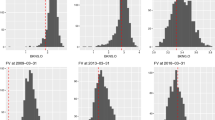Abstract
The role of selling (or marketing) period uncertainty in understanding risk associated with property investment is examined in this paper. Using an approach developed by Lin (2004), and Lin and Vandell (2001, 2005), combined with a statistical model of UK commercial property transactions, we show that the ex ante level of risk exposure for a commercial real estate investor is around one and a half times that obtained from historical statistics. The risk related to marketing time uncertainty can be reduced by constructing a portfolio. We find that at least ten properties are necessary to reduce this risk, assuming independence between marketing period risk and price risk. These findings have important implications for mixed-asset portfolio allocation decisions.
Similar content being viewed by others
References
Amihud, Y. (2002). Illiquidity and stock returns: Cross section and time series effects. Journal of Financial Markets, 5(1), 31–56.
Amihud, Y., & Mendelson, H. (1986). Asset pricing and bid-ask spread. Journal of Financial Economics, 17(2), 223–249.
Anglin, P. M. (2003). The value and liquidity effects of a change in market conditions. Mimeo, Department of Economics, University of Windsor.
Bond, S. A., & Hwang, S. (2003). A measure of fundamental volatility in the commercial property market. Real Estate Economics, 31, 577–600.
Bond, S. A., & Hwang, S. (2005). Smoothing, nonsynchronous appraisal and cross-sectional aggregation in real estate price indices. Paper presented to the American Real Estate and Urban Economics Association Annual Conference, Philadelphia.
Collet, D., Lizieri, C. M., & Ward, C. W. R. (2003). Time and holding periods of institutional real estate. Real Estate Economics, 31(2), 205–222.
Crosby, N., & McAllister, P. (2004). Disconstructing the transaction process. Investment Property Forum Working Paper 2 in the series on Liquidity in Commercial Property Markets.
Easley, D., Hvidkjaer, S., & O’Hara, M. (2002). Is information risk a determinant of asset returns? Journal of Finance, 57(5), 2185–2221.
Feldman, B. E. (2003). Investment policy for securitized and direct real estate: Correcting for liquidity. The Journal of Portfolio Management: Real Estate Issue, 112–121.
Fisher, J., Gatzlaff, D., Geltner, D., & Haurin, D. R. (2003). Controlling for the impact of variable liquidity in commercial real estate price indicies. Real Estate Economics, 31(2), 269–303.
Fisher, J., Gatzlaff, D., Geltner, D., & Haurin, D. R. (2004). An analysis of the determinants of transaction frequency of institutional commercial real estate investment property. Real Estate Economics, 32(2), 239–264.
Hudson-Wilson, S., Fabozzi, F. J., & Gordon, J. N. (2003). Why real estate. The Journal of Portfolio Management: Real Estate Issue, 12–24.
Key, T. (2004). Defining liquidity in property. Investment Property Forum Working Paper 3 in the series on Liquidity in Commercial Property Markets.
Lin, Z. (2004). Essays on illiquidity and pricing bias in the real estate market, PhD dissertation, University of Wisconsin-Madison.
Lin, Z., & Vandell, K. D. (2001). Illiquidity and real estate risk. Paper Presented to the Asian Real Estate Society Annual Conference, Tokyo.
Lin, Z., & Vandell, K. D. (2005). Illiquidity and pricing biases in the real estate market. Working Paper, University of Wisconsin-Madison.
Pastor, L., & Stambough, R. (2003). Liquidity risk and expected stock returns. Journal of Political Economy, 111(3), 642–685.
Author information
Authors and Affiliations
Corresponding author
Rights and permissions
About this article
Cite this article
Bond, S.A., Hwang, S., Lin, Z. et al. Marketing Period Risk in a Portfolio Context: Theory and Empirical Estimates from the UK Commercial Real Estate Market. J Real Estate Finan Econ 34, 447–461 (2007). https://doi.org/10.1007/s11146-007-9022-1
Published:
Issue Date:
DOI: https://doi.org/10.1007/s11146-007-9022-1



